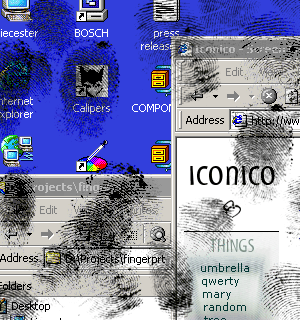Look at your monitor. No, closer. See the smudges? The smudged fingerprints from colleagues pointing at a bug, or maybe your own from a moment of frustration? Those marks are a physical record of interaction. Residuals of intent, explaination or expounding on an idea.
That observation was the seed for a project back in 2003. It was an era when CRT monitors, with their glowing phosphor screens, were ubiquitous. Leaving a static image on screen for too long would permanently "burn" it into the display, leaving a spectral afterimage. Screensavers weren't just decoration; they were a necessary utility, a constantly moving pattern to prevent the degradation of your expensive hardware. The idea was to hijack this utility. To take something designed to prevent afterimages and use it to create them. What if the fingerprints weren't your own, but those of strangers from across the web?

The Concept: Ambient Connection
'Dirty Fingerprints' is a screensaver that creates a shared, ambient space. It gathers mouse-clicks from a network of websites and renders them on your screen. A simple script on a participating website captures the X,Y coordinates of a click. A central server stores them. The screensaver then pulls the latest click and displays it as a greasy, semi-transparent fingerprint.
Every few minutes, a new smudge appears. It isn't a notification or a message. It’s a quiet, persistent reminder of other people out there, interacting with the same digital fabric. A slow, ambient accumulation of missed human connections; a collaborative, anonymous, and slightly grimy piece of digital art.
The Click-Gathering Network
The network operates on a simple principle of open collaboration. By adding a small, invisible script to a webpage, a site becomes a node, contributing the clicks of its visitors to the collective.
This mechanism is a product of a different era of the web, one less concerned with data harvesting and more with novel forms of connection. It comes from a pre-touchscreen world, where the primary mode of interaction was a mouse. Every click was a deliberate, singular event at a precise XY coordinate. There were no swipes, no pinches, no long presses. Just the click. The script doesn't track users or gather data; it just reports that one anonymous, definitive gesture. It captures a trace of a touch that becomes a shared artifact, a digital fossil from a time of more intentional interaction.
Javascript Include
You can still add the script to your site. It works on all modern browsers.
<script src='https://www.nicowesterdale.com/the-lab/dirty-fingerprints-screensaver/dirtyfinger.js'></script>

Modernizing the Machinery
Keeping this project running has meant updating the technology while preserving the original, simple architecture. The original 2003 stack was a product of its time: an ASP endpoint on a Windows server writing to a text file, with the screensaver itself being a compiled Delphi executable.
Today, the machinery is more robust. The ancient ASP endpoint is now a serverless function. The text file "database" is a blob in Cloud Storage. The core logic remains identical: a globally distributed system for storing and retrieving a single set of X,Y coordinates. It's an architecture of profound simplicity, now running on an infrastructure of profound complexity.
The original screensaver executable, from 2003, is still available and thanks to the backend modernization, is fully functional. It will faithfully call the new endpoints, just as it did two decades ago.
Note: This is the original 2003 executable. It still works, though your modern OS might have some opinions about running software older than some of its core developers.